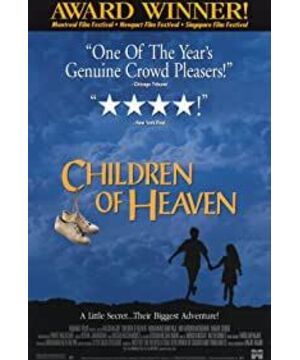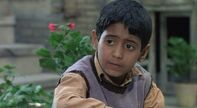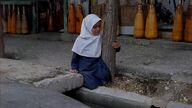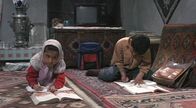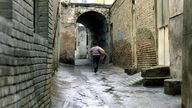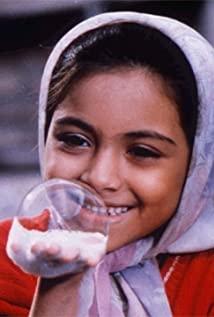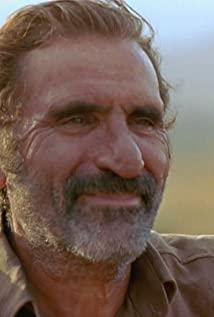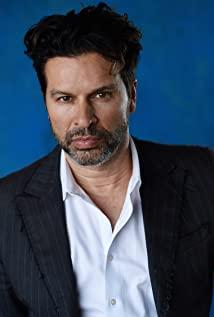The whole narrative of "Little Shoes" revolves around a pair of small shoes in chronological order. In the film, the protagonist Ali lost his sister Sarah's shoes, and narrated the life of the two brothers and sisters after losing the shoes as the main plot. Director Majid took the title of the film "Little Shoes" straight to the point, and the first shot of the whole film is a close-up long shot of a pair of small shoes, which simply and directly makes the audience's attention focus on the important clue of the film: small shoes.
The film establishes an ordinary and simple tone from the beginning, and this simple and true style makes the story told and the emotion expressed in the film especially true and moving. The straight-to-the-point close-up long shot of shoe repair naturally completes the setting of the story background: the poor life of the poor and the bitter tone of society. Then the shot briefly cuts to the middle shot where the protagonist Ali is sitting and waiting, and then the camera follows Ali's movement trajectory for a simple and direct switch. It is worth noting that the entire film basically uses an objective point of view to narrate, placing the audience in an omniscient perspective, which further enhances the film’s intentional sense of reality. In addition to using an objective point of view to narrate this sense of realism, the director deliberately avoided complex and diverse editing to ensure the realism of the film, and deliberately reduced the movement of the shots, basically focusing on fixed shots and some simple panning shots. . For example, in the scene where Ali lost his shoes - looking for shoes, Ali walked out of the vegetable store. At this time, the camera followed Ali's steps towards the outside of the store and moved backwards, making the scene bigger and incorporating the scenes that were originally outside the camera into the camera. , while ensuring the integrity of the scene while maintaining the coherence of the characters' actions, it objectively and naturally presents the plot of Ali's rush to find when he finds that he has lost his shoes.
In addition to reducing the movement of the camera in the camera technique, Majid also avoids using condescending overhead shots to give them depression or pity, but mostly uses a flat angle to create an equal psychological status, from a more unadulterated The objective and real perspective of impurities interprets the rich inner world of children, giving the film a more natural emotion of humanistic care. For example, in the dialogue between Ali and the wealthy where Ali was caught late and was caught by the director, Ali was all shot in front of the camera, implying a sense of dignity and equality.
Although the use of objective and calm techniques to create a realistic style is a major feature of this film, the reason why it can fully arouse the emotions of the viewers does not stop there. In a scene in which Ali participated in a race, there was a flashback of Sarah running to deliver shoes, and then there was a sound and picture confrontation: the dialogue between Ali and Sarah about shoes and Ali running hard in the picture formed a A strong and touching contrast. These audio-visual languages revealed to the audience Ali's inner activities at this moment, exaggerated the tense and determined emotions, and conveyed to the audience Ali's belief: for Sarah, he would win the third place. Such audio-visual language in order to mobilize the audience's emotions does not only appear this time. For example, in a later episode, the director used an upgrade when Ali was approaching the end to mobilize the audience's nervous emotions again; In the lucky scene, the director used accumulation montage to compress time and space, so that Ali and his father ran into a wall again and again, aroused the audience's empathy, and caused the audience to feel disappointed. Enough emotional padding.
"Little Shoes" also has a major stylistic feature in the narrative: it uses detailed descriptions to foreshadow, explain the reasons, promote the development of the plot, and enrich the characters' characters. In Ali's potato purchase, Ali's poor family is portrayed from the side through the dissatisfaction of the shopkeeper's dissatisfaction with Ali's family's too much credit, which explains why Ali is so anxious because of the loss of a pair of worn-out shoes; when Sarah pours tea for her father In this scene, Sarah saw that her father was full of sacrificial sugar, so she didn't bring him any more sugar, but the father gently told Sarah that these sugars were not his own, even if there was more sugar, he could not use a piece of sugar. , Such details form a contrast with the sternness of his father's scolding of Ali before, which enriches and enriches his father's character image. This method of paving the way with details makes up for the insufficiency of the film's chronological mode, which easily makes the story less dynamic, and increases the richness and thickness of the film.
As mentioned at the beginning of this article, the small shoes are an important narrative clue of the whole film, and the plot basically revolves around the "little shoes", but in fact Majid also used an imagery approach to this clue to make the clues Instead of being confined to the pair of old shoes of his sister that Ali had lost, a series of natural, not rigid transfers took place. In the plot, that pair of sister's old shoes predominately occupies the most important position in the film, but in the episode where Sarah finds the little shoes - follows Yabao - the little shoes are completely thrown away, it is the second part of the old shoes. After the first appearance, the clue of the old shoe has fully played its role in promoting the development of the plot, and the clue of "shoe" has been completely imaged as an idea that runs through the rest of the film: give Sarah a new pair. shoe. And this is reflected in the movie. For example, in the second half of the film, the imaged "little shoes" are mainly Ali's tattered shoes, and these shoes promote the development of the story, including Ali's tattered shoes. Being caught late by the director, Ali wearing sneakers to participate in the race, etc.; like other "small shoes" image transfer: the close-up of the shoe image on the TV directly counteracts the facial expressions of Che Ali and Sarah who are watching TV intently Close-up, at this time, the imaged "small shoes" are the children's desire for shoes. This method of visualizing clues through reasonable plots and simple and natural techniques is also a major feature of the film's narrative.
In the sound design, Majid also deliberately played its role in shaping the atmosphere. For example, use sound to help transitions: increase the volume of the clock ticking when Ali listens to his parents talking and fall asleep, and connect to the sound of the next class bell, trying to make transitions natural and smooth; another example is to use appropriate music Rendering the mood of the characters: In the scene where Sarah was chasing the shoes that fell into the ditch, a tense and fast-paced music was added to express Sarah's anxious mood at this moment, and as Sarah chased, the rhythm of the music became more It came faster and faster. When the shoes got stuck under the bridge, the music slowed down and the violin ended slowly with a little whimper, which not only reflected Sarah's mood from anxiety to panic and grievance, but also made the audience's visual and auditory sense. All focus on this panicked chase and stimulate the audience's sense of substitution. And this mode of strengthening the music and sound effects to set off the mood of the characters and render the atmosphere of the plot has also appeared many times in the film. Following the camera to focus on Ali, Ali's panting while running and the sound of his feet on the ground are intentionally amplified, enhancing the concentration and tension of his emotions.
The use of contrast and contrast is also a style characteristic of this film. In the episode of Ali going to the race, the camera first showed multiple shots of other participating children being cared for by their parents and teachers, and then switched to a shot of Ali watching them changing clothes on their own. This contrast The stark difference between the two treatments that the montage shows highlights Ali's own shabbyness. This mode of application of contrast montage also reappeared in the plot of Ali winning the championship, strengthening the sharp contrast and creating a unique psychological feeling of the characters. The contrast is mainly used in large plot segments, such as the contrast between Sarah and Yabao, and the contrast between Sarah's family and Yabao's family, in order to express a general bitterness and helplessness in the life of the people at the bottom.
The film adopts a semi-open ending, using an omniscient perspective to tell the audience that the father has bought new shoes for the two children, and at the same time, Ali, who has not yet been informed, returns home with remorse for not getting the third runner-up. Instead of showing us the kid rejoicing with his new shoes, the camera ends the movie with a large bird's-eye view of Ali sitting by the fish pond. With such a blank space, the movie gives the audience space to reminisce, and sublimates the main theme of the whole movie: pure and warm love.
View more about Children of Heaven reviews


